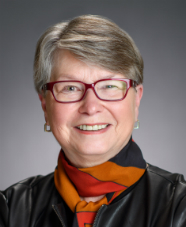From the Executive Director: Power: n., energy, force or momentum
 Were you perhaps the slightest bit uneasy to see the word power on the front cover of this issue of the Forum? Did you perhaps pause before opening the pages to imagine how multiple meanings of that single word might be employed by the writers and columnists?
Were you perhaps the slightest bit uneasy to see the word power on the front cover of this issue of the Forum? Did you perhaps pause before opening the pages to imagine how multiple meanings of that single word might be employed by the writers and columnists?
My scholarship on the role of women in religion focused on one meaning of power – authority. Specifically, by what means, and what authority, does a church body determine who may or may not serve as clergy, deacons, or in any leadership capacity? Who can speak, and who says so?
That question came to the forefront on March 24 when the student survivors of the Valentine’s Day shooting at Marjory Stoneman Douglas High School in Florida organized a massive protest against gun violence in Washington, D.C., and in cities around the country and world. Critics challenged the leaders of the movement, most not yet old enough to vote, as to their authority to speak.
But speak they did, and in their speaking was power.
Students from Parkland, Chicago, Newtown, students who had huddled together seeking safety from gunfire, students who had lost siblings and friends, students who have grown up practicing active shooter drills like some of us practiced duck-and-cover during the Cold War. These young voices are saying enough and calling for change in laws that they believe might offer them the opportunity to focus classroom time on their studies rather than their safety.
This is power.
Young people were on the front lines of another movement that changed America, the civil rights movement of the 1950s and 60s. The Little Rock Nine were ninth-graders, Emmett Till was 14 when he became a symbol of the brutality of the Jim Crow era, Ruby Bridges was in kindergarten when she had to be escorted by U.S. marshals to attend the white school only five blocks from her New Orleans home, the Greensboro Four were college students when they sat down at a lunch counter, children marched in the Children’s Crusade in Birmingham in 1963 only to be met with snarling dogs and water cannons.
In that same decade, other young people grew energized through activism against the Vietnam war. Like those of the Parkland students, the ‘60s protests were born in personal experience of discrimination and war. Images from then and now reveal the raw emotions of lives damaged and lost. Chants from then and now demand change: “War is not healthy for children or other living things,” “Never again.”
Commentators have noted, however, a signal difference in this spring’s protests. Marked by diversity, this movement reflects what one writer called intentional intersectionality. Marked, too, by hope, the speakers called for positive change. They were marching, as they said, for their lives.
As an educator, I felt enormous pride listening to the voices of teens and preteens as they shared both candor and pain. They had been well taught – not coached, as some critics insisted – but taught how to express their hopes and fears through telling the stories of their lives. The times, they are a-changing.